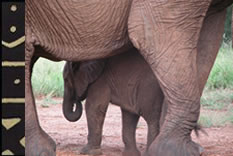News
If you want to see the news history of Mr BRRRRR, choose him from the list of categories
British High Commissioner's speech on arrival of the new rhinos
SPEECH BY BRITISH HIGH COMMISSIONER TO TANZANIA DIANE CORNER AT MKOMAZI NATIONAL PARK, 17 JUNE 2012
Hon Minister Ambassador Khamis Kagasheki, Minister for Natural Resources and Tourism, Hon Regional Commissioner, Hon Members of Parliament , Mr Damien Aspinall of The Aspinall Foundation, Distinguished guests, ladies and gentlemen.
I am honoured to have been asked to be here today at the handover of three black rhinos from the United Kingdom to Tanzania.
Today’s handover is an extraordinary example of the partnership between our two countries, a partnership which has many different aspects. For this extraordinary event today would not have been possible without many people in Tanzania and in Britain working together in common purpose, to save this critically endangered species, the eastern black rhinoceros.
I’d like to thank those who have been involved in this extraordinary operation. In particular I’d like to single out the following.
Damian Aspinall and Amos Courage of The Aspinall Foundation and Port Lympne Wild Animal Park for so generously donating the three black rhinos. Also for breeding them so successfully in England and for taking the initiative to return them back to the wild to a place where they will be well protected.
Tony Fitzjohn of the George Adamson Wildlife Preservation Trust and his talented and dedicated Tanzanian team, for building, stocking and managing the Mkomazi Rhino Sanctuary to a highly professional level where they are able to accept the donation of the rhinos, protect them, breed them up and perpetuate this very precious species.
The Chairman and Trustees of Wildlife Preservation Trust Fund under whom Tony and his team work in Tanzania, in particular the Chairman of this Trust, Bernard Mchomvu, for being so involved in this translocation and for ensuring that the arrival of the rhinos went smoothly.
Dr Idrissa Chuma of TANAPA for helping coordinate the translocation.
Chief Park Warden Mr Mnyagatwa for helping protect Mkomazi National Park.
Director General of TANAPA Alan Kijaze for working so hard to ensure the rhino translocation went smoothly.
Tusk Trust for being supportive of the George Adamson Trust and Mkomazi Rhino Sanctuary for so many years and for introducing the Trust to the DHL team. And I’d like to mention that Prince William is the patron of Tusk Trust, and he went to see these rhinos just before they left the UK for Tanzania.
DHL for so generously pulling one of their huge 757 aircraft out of circulation, and donating it to this rhino translocation. This is an extremely benevolent gesture to a species that needs all the help it can get.
I know that Tony and Lucy Fitzjohn also want me to thank Suzuki Rhino Club, who have unfailingly supported many of the running costs of the Mkomazi Rhino Sanctuary for many years.
Finally, special thanks to Dr Peter Morkel, who I'm told is the best rhino vet in the world, who has translocated the rhinos from the UK to Tanzania and who has brought his expertise to the Mkomazi Rhino Sanctuary since it's inception in 1995.
Ladies and gentlemen, I’d like to just mention that Britain and Tanzania share very common aims in protecting the remaining rhinoceros population. The remaining wild population of the eastern black rhino is now thought to number less than 800 individuals, many of course killed because of the mistaken belief that the horn has medicinal purposes. The horn is in fact made of keratin – the same as human hair – and has no medicinal value at all.
For its part, the UK has led work in Europe to put in place strict control of trade in rhino horns in and out of the EU. We also helped set up a CITES international working group in 2011, chaired by the UK, to look at measures to prevent poaching and counter its impact on wild populations. Our position is that we are strongly opposed to any proposals to allow the legal sale of rhino horn because numbers in the wild are so low. It’s worth noting that we are not convinced that the recent controlled sale of elephant ivory has helped reduce poaching of that species.
I’d like also to pay particular tribute to the firm action that Minister Kagasheki, here with us today, has taken to investigate the killing of two rhinos in the Serengeti. We hope that the investigations into this tragic incident will conclude swiftly, with the reinstatement of those found not to have been involved, and stern punishment for the perpetrators in accordance with the law. This action sends a strong signal of Tanzania’s determination to protect this critically endangered species.
In conclusion, I’d like to say few words about the real stars of today’s show – the three rhinos. I’m sure I speak for everybody here in wishing them every success in moving into their new home in Tanzania. They join a small population of rhinos here in Mkomazi. In the 1960s, there were between 150 to 200 rhinos in Mkomazi, but by 1989 there were none left. The rhinos are now back, under proper protection, and starting to thrive. But their numbers remain very small. I know that everyone here today hopes that the 3 new arrivals will settle in well, and of course, that they will breed, to build up this critically endangered population.
My country Britain salutes the work going on in Tanzania to preserve this remarkable animal. The eyes of the world are on this – for good and sadly for ill as well – and we all need to remain constantly vigilant. Your efforts to save the rhino benefit us all, and may God bless Tanzania in living up to the trust we all place in you.


